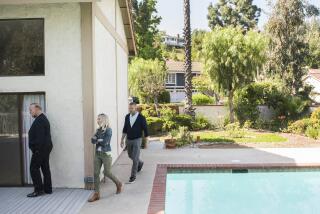Prices of homes at 2005 levels
Welcome to 2005.
If you’re a typical Southern California homeowner, the value of your house is back to what it was that year thanks to the weak real estate market, according to a report released Wednesday. And if the trend continues, it could soon be 2004 all over again.
The median price last month was $444,000, the lowest since April 2005, according to DataQuick Information Systems. That’s a 3.9% drop from September and an 8% decline from October 2006.
The number of homes sold, meanwhile, slipped to a 20-year low.
Kurt Freck didn’t need to see the latest numbers to know that the housing market is getting worse.
He’s had the Anaheim Hills home he bought in 2003 on the market for nearly a year and has lowered the price by $100,000 -- a 12% discount from his original asking price of $849,000.
“The good thing is that I paid less than that, but I have definitely lost equity,” Freck said. He bought the house for less than $500,000 four years ago.
Freck’s story is becoming more common as fewer people have been willing to buy a house at current prices.
“It looks pretty dismal,” said economist G.U. Krueger of IHP Capital Partners, an Irvine residential real estate investment firm.
Krueger said part of the problem was that the mortgage meltdown triggered by rising defaults has made it tougher for people to get jumbo loans, or those that exceed $417,000. Conventional loans below that amount, he said, remain widely available.
For home sales to pick up, Krueger said, prices need to fall “to within striking distance of [conventional] loan limits.”
Current price declines are moving the market in that direction, he said.
“Riverside is already there, San Bernardino is there, San Diego is closer, all of Southern California is closer,” he said.
For its monthly report, DataQuick counts all homes sold -- including new houses, existing houses and condominiums. It tracks values based on the median price, or the point where half the homes sell for less and half for more.
Repeating a pattern, the steepest price declines last month were in Riverside County, where values fell 15.1%. Los Angeles County saw a 3.8% decline in median values.
“The extent of the pain is not evenly distributed,” said USC economist Raphael Bostic.
Riverside County was a center of home construction during the recent housing boom, attracting thousands of new buyers looking for affordable housing.
Many of those buyers have gone into default, however, often because they were unable to make higher payments under their adjustable-rate mortgages.
DataQuick’s chief analyst, John Karevoll, said that though there was plenty of bad news in the latest report, there were a few potentially positive signs as well.
Foreclosures are at record levels, but risky financing with adjustable-rate mortgages and multiple mortgages has dropped because of tightened lending standards.
Also, bargain-hunting speculators appear to be tiptoeing back into the market, which could be a sign that they think the bottom is near, he said.
DataQuick said sales to nonresident owners were up in October to 22% of sales, from 18% a year ago. Typically, such buyers are investors looking to rent out or resell a property.
“It’s too early to tell, but it could be a sign bottom-fishers are coming back into the market,” Krueger said. “It could be the silver lining we have not seen in a long time.”
But recovery won’t be quick. When prices do find their low point, they will follow the historical pattern and “drag along the bottom for a while before they go up,” Karevoll said.
That would be bad news for anyone who recently purchased a home and has been hoping to sell at a profit.
But a cyclical downturn doesn’t concern Richard Schmidt, a music-industry marketing executive who bought a four-bedroom house in the Country Club Park section of Los Angeles in 2003.
Schmidt, 52, says he thinks his house is still worth more than what he paid for it -- less than $700,000.
Even if it falls below that price, however, Schmidt says it won’t matter to him because he and his wife don’t plan to leave for at least 10 years. By then, they expect the younger of their two sons to be out of college.
Schmidt and wife Kathi Sweet rode out the early-1990s real estate crash. They bought a house near the top of the market in 1991 and then saw prices around them plummet.
But they didn’t sell that place until 2003, when it was snapped up in a week, and for more than the asking price.
“It’s a cycle,” Schmidt said. “It goes up, it goes down. But we’re in for a long time. It’s not an up-or-down thing for us.”
More to Read
Inside the business of entertainment
The Wide Shot brings you news, analysis and insights on everything from streaming wars to production — and what it all means for the future.
You may occasionally receive promotional content from the Los Angeles Times.









